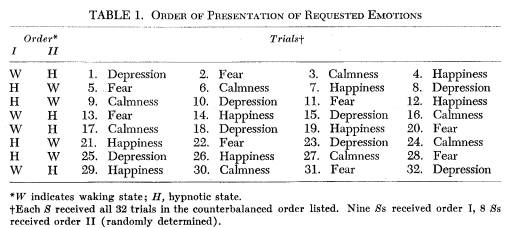
ESTHER C. DAMASER, M.A., RONALD E. SHOR, Ph.D., and MARTIN T. ORNE, M.D., Ph.D.
It was demonstrated that consistent physiological changes occur in response to hypnotically requested emotions, but that similar changes occur just as readily during waking control conditions, and can be produced just as clearly by Ss simulating hypnosis. The findings place the burden of proof upon anyone who wishes to assert an extravoluntary nature for such physiological effects.
REPEATED ASSERTIONS have been made in the literature of hypnosis that emotional states induced by means of hypnotic procedures are accompanied by extensive physiological changes consistent with the type of emotion suggested.1-4, 6, 8,12-17 The assumption, tacit or stated, in these studies is generally that such physiological changes are not under voluntary control and are therefore not within the behavioral repertoire of the waking S. For example, Reiter 11 concludes ". . . it has been evidenced that during hypnosis it is practicable through suggestion to provoke pronounced changes within a field of function which is vegetatively regulated. The changes will be more pronounced the more intimately the suggested emotional state is correlated to the relationship between the adrenals and the sympathetic nervous system." Gorton 5 concludes, "it is . . . clearly established that hypnotic suggestion is capable of bringing about physiological changes which differ significantly from those produced by means of suggestion in the waking state. There is good reason to believe that these changes differ quantitatively and qualitatively from those which can be obtained voluntarily."
The present study was designed to place these assertions into critical perspective. No attempt was made to repli-
This work was supported by Research Grant M-3369 from the U. S. Public Health Service, National Institute of Mental Health, and by a grant from the Human Ecology Fund. We wish to thank our co-workers, Emily Carota Orne and Donald N. O'Connell for their critical comments and editorial assistance in the preparation of this manuscript. Much appreciation is due Dr. Ulric Neisser, Brandeis University, for his suggestions, and Mr. Bernard Tursky, Psychophysiology Laboratory, Massachusetts Mental Health Center, for his technical assistance.
Received for publication Nov. 19, 1962.
334
335 DAMASER ET AL.
cate the procedures of any single prior study; instead, the objective was to represent their common denominator. Although the experimental design required repeated measurements and other attention to statistical clarity, only minimal procedures were used for inducing the "emotions" and no attempt was made to assure that Ss experienced the "emotions" in a manner subjectively convincing to themselves. In brief, the study did not try to prove that resultant physiological effects are purely voluntary; rather, it was limited in scope to demonstrating that evidence for extravolitional effects is markedly deficient, in order to serve as a critical standard against which to evaluate other findings.
Method
Design
On the basis of pilot work, four emotional states that appeared to differ in physiological characteristics were defined by the experimenter and selected for the study. These states were: Fear, Calmness, Happiness, and Depression. It was expected that on physiological indices either Fear or Happiness would be the most active emotion and either Calmness or Depression the least active.
As Lacey 7 and others have demonstrated there are often large individual differences in patterns of autonomic responses. When such data are statistically grouped, changes which are significant within individuals may be lost. For this reason the experiment was designed so that sufficient data would be secured from each S to permit a separate statistical analysis of each S's record, in addition to a group analysis.
Each of the four emotions was requested from each S 8 times -- 4 times in the waking state and 4 times in hypnosis. The order of testing was a latin square design repeated twice in a manner that controlled for carryover effects from one emotion to the next, and controlled for more general order effects occurring over time. The order in which the emotions were requested appears in Table 1. Waking and hypnotic conditions were alternated so that 8 Ss began with the hypnotic state and 9 with the waking state.
Subjects
Two groups of Ss were employed who had received training in hypnosis by E's associates. The first group consisted of well-trained hypnotic Ss capable of readily entering moderate to very deep hypnosis (Reals). The second group was

336 HYPNOTICALLY REQUESTED EMOTIONS
made up of individuals who, throughout several hypnotic training sessions, had remained unaffected by the hypnotic induction procedure. These latter Ss were asked by the associates to simulate hypnosis during the entire experiment, and were told to "fool" both the E and the polygraph machine. These Simulators were given no special instructions on how to behave but were told to rely on their general impression of how a hypnotic S might behave. They were given a truthful description of the situation -- that is, that E would know that some Ss were real hypnotic Ss and that some, like themselves, were simulating; that E would not, however, know which Ss were simulating, but that E would terminate the session if, during the course of the experiment, it became apparent that they were simulating. This special group of simulating Ss has been described in detail by Orne. 10
Seventeen college undergraduates served as Ss. Eight were Real hypnotic Ss, 9 were Simulators. Ten Ss were male and 7 were female. Cross-frequencies were as follows.
| Reals | Simulators | |
| Male | 4 | 6 |
| Female | 4 | 3 |
Apparatus
During the experiment the S was placed in a relatively soundproof and temperature-controlled room. The physiological changes were recorded by means of an appropriately converted Offner, type D, electroencephalograph. The following polygraphic parameters were utilized in this analysis: heart rate, recorded with an electrocardiograph; muscle activity, recorded with Grass silver electrodes centered bilaterally over the frontalis muscle of the forehead; and skin potential, recorded with silver-silver chloride sponge electrodes (O'Connell & Tursky 9).
Procedure
After recording electrodes were attached to S, E explained that S's task was to try to experience the four emotions which E described. The instructions were as follows:
This is an experiment in emotion. I would like you to try to feel the emotions which I will name and describe. When you really feel emotions, you feel them with your body too. I would like you to try to really feel the emotions but to try not to thrash around in the chair. It might help you to make the facial expressions consistent with the emotions as you have perhaps noticed radio actors do even though nobody can see them. It might also help you to think of images or past situations in which you have felt these emotions. Do whatever you feel will help you the most, but please try not to move around too much.
There are four emotions. These are: (1) Fear -- an intense fright, almost complete panic; (2) Calmness -- peacefulness, serenity; (3) Happiness -- giddy joy, you feel wonderful; (4) Depression -- a completely exhausted emotional state as if you had no emotional or physical energy left. I will give you the name of the emotion and then I will say "start," at which time I would like you to begin feeling the emotion. Then there will be about one and one-half minutes of rest during which time I would like you to try not to think of anything and to be as neutral as you can. Then I will give you the next emotion. You will get each emotion 8 times. They will be in mixed up order so that you will not know which is coming next.
Part of this experiment will be done in hypnosis and part will be done in the waking state. I will indicate which one we are to do as we go along. It will probably help if you keep your eyes closed even when you are in the waking state.
Depending on the prearranged design, either the first waking series was run immediately (Order I), or hypnosis was induced, hypnotic depth roughly determined, and the first hypnotic series run (Order II).
337 DAMASER ET AL.
During the emotion intervals, E described the emotion to the S in a tone of voice which was appropriate to the desired mood. These descriptions were as follows:
Fear: You feel terribly frightened. You're horribly scared as if something terrible were going to happen to you and there was nothing you could do to prevent it. You're absolutely panicked, terrified, petrified, frantic. It's worse than a nightmare.
Calmness: You feel utterly peaceful, completely serene as if there were no conflict inside you or outside in the world. It's like watching the sun set on a peaceful countryside or maybe lying on a beach in the warm sun. Nothing is bothering you; you feel completely calm, peaceful, and serene.
Happiness: You feel wonderful. As if something marvelous has happened and you're giddy with joy about it. It's almost like being a little drunk, slightly intoxicated. You feel exhilarated, exuberant, ecstatic, euphoric.
Depression: You feel emotionally and mentally all worn out as if you had no energy left to do anything or think about anything or feel anything except how tired you are. You feel completely worn out, wrung out, exhausted.
The Ss were required to participate in each emotion condition for a 1-min. period. A rest interval of approximately 80 sec. preceded each requested emotion.
Results
As noted above, three physiological indices were measured: heart rate, skin potential, and muscle activity. Average readings were taken for each of the 32 1-min. emotion periods per S, and for the final minute of each preceding rest period.* In order to eliminate any systematic effect of these preceding rest period levels a partial regression equation was used on heart rate and on skin potential data. In this way correlations between prior resting level and the emotion scores were eliminated. These adjusted scores were used for the further analyses. Since the scores for muscle activity proved independent of prior resting level they were not so adjusted.
Mean emotion scores for each S for all conditions and grand means for groups are presented in Table 2.
Each S's data on each physiological variable were analyzed separately in the form of an emotions-times-states factorial analysis of variance. The emotions-times-states-times-subjects format was used to analyze the group data. It should be noted that the comparisons above dealt with Reals and Simulators separately and did not compare across these two groups.
Results of these analyses of variance are summarized in Table 3. Reported are the probability levels (where significant) associated with the F-ratios for the three major variance components -- between emotions (E), between states (S), and the interaction (I). Also presented are combined probabilities for each column. These combined probabilities are based on the binomial distribution.
Four general findings emerge:
1. The means and their respective probability levels demonstrate that consistent physiological changes did occur.
2. There is a clear tendency for Fear to be the most active emotion and for Calmness to be the least active. Fear is the most active emotion in both groups
338 HYPNOTICALLY REQUESTED EMOTIONS
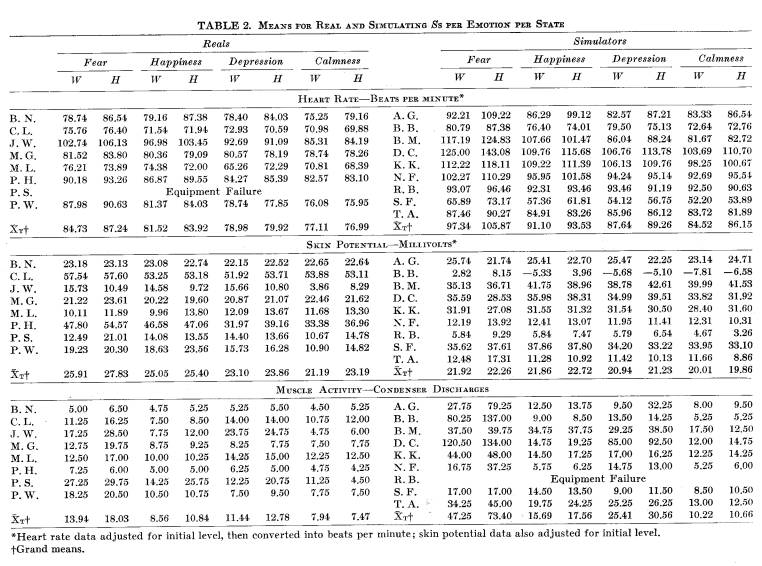
339 DAMASER ET AL.
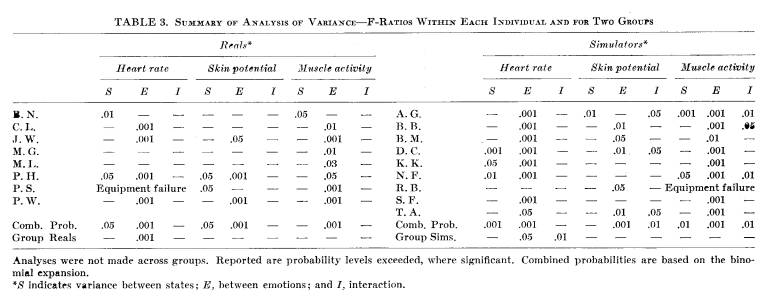
340 HYPNOTICALLY REQUESTED EMOTIONS
15 out of 16 times for heart rate, 9 out of 17 times for skin potential, and 16 out of 16 times for muscle activity. Calmness is least active in both groups -- 13 out of 16 times for heart rate, 9 out of 17 times for skin potential, and 13 out of 16 times for muscle activity. Calmness is the highest emotion mean only twice; Depression is highest only 3 times -- all in skin potential. Only 5 times is Fear the lowest emotion mean -- again all in skin potential. The over-all tendencies here are clearly beyond chance and fit our general expectations. Thus the physiological responses tend to parallel the types of emotion requested.
3. Although there are individual differences, it is clear that in a large proportion of cases individuals in both experimental groups manifest significant differences between emotions for all three variables. The combined probabilities for both groups on the three physiological variables all exceed the .001 level. As was anticipated, these significant individual patterns are often lost when the data are pooled and group analyses are made.
4. Because any differences in physiological reactions to the requested emotions in the hypnotic and waking states would be reflected in a greater dispersion among the four emotion means, and not as a general shift in the same direction for all emotion means, the Interaction variance component is the appropriate index of comparison between waking and hypnotic states. No S in the Real group showed any significant Interaction component for any physiological variable; and, of course, none of the combined probabilities are significant for this group. The Simulating group, however, manifested significant combined probabilities for the skin potential and the muscle activity variables.
Thus, the evidence does not support the view that either (1) effects in the hypnotic state are larger than in the waking state, or (2) effects in the Real group are more frequent than in the Simulating group.
A further analysis was made in regard to the magnitude of differences found in the Real group as compared with the Simulating group. As a measure of magnitude we utilized the range of each S's response between the mean scores for the highest and lowest emotion (usually Fear and Calmness) in the hypnotic state. Dispersion scores were plotted, found not too abnormally distributed, and simple analyses of variance were computed. The low hypnotic emotion means were similarly analyzed. The dispersion score findings were then adjusted by the technique of analysis of co-variance to eliminate any systematic effect of the low means (initial level). The crucial steps in these analyses are summarized in Tables 4 and 5. In Table 4 are presented our measure of dispersion, the high and low hypnotic emotion means, and their differences. Table 5 summarizes the results of the analyses of variance and co-variance.
It can be observed that the Simulating group mean dispersion scores for all three physiological variables are larger than the respective means of the Real group. Except for muscle activity scores, however, little statistical confidence can be placed in these differences. The overall conclusion is nevertheless warranted that Real hypnotic Ss do not show wider dispersion in physiological responses than do Simulating Ss.
Discussion
It is recognized that this single study does not deal with the myriad of variables which undoubtedly relate to the physiological effects of hypnotically requested emotions. Our findings may well be amended when other investigators utilize more complex hypnotic, motivational, and imaginal techniques for producing emotional responses. It may
341 DAMASER ET AL.
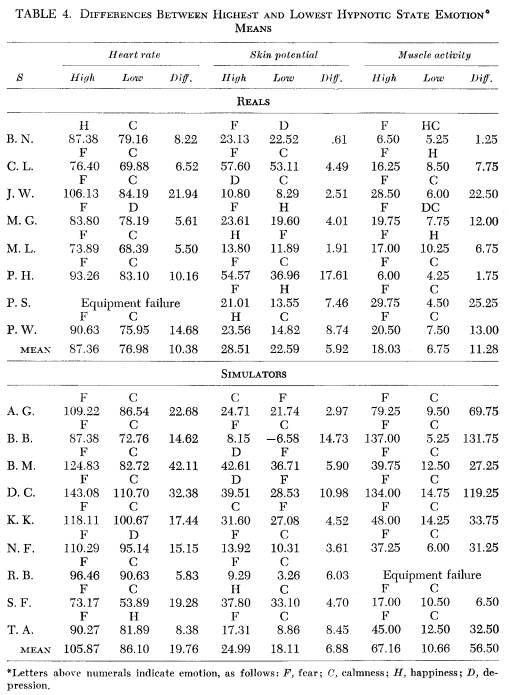
342 HYPNOTICALLY REQUESTED EMOTIONS
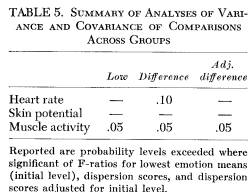
prove valuable to compare the physiological effects of hypnotically requested emotion with those of actual emotional incidents, to use other physiological measures, to study the S's subjective experiences during the alleged emotions, to use other types of control groups, to compare effects under conditions of more restricted motility and breathing, and so forth.
Our study, avowedly limited in terms of all the potential variables involved, has nonetheless demonstrated that:
1. Consistent physiological changes occur in conjunction with hypnotically requested emotions.
2. Similar physiological changes can be produced by Simulators, and by Real hypnotic Ss during waking conditions.
3. Real hypnotic Ss do not show a wider dispersion in these physiological responses than do simulating Ss.
The findings thus place the burden of proof upon anyone who wishes to assert an extravoluntary nature for such physiological effects. Until physiological effects of hynotically requested emotions are found which defy exhaustive attempts to reproduce them voluntarily, it would seem to be proper scientific caution to remain skeptical of assertions that these effects are beyond the usual realm of voluntary control.
Massachusetts Mental Health Center
74 Fenwood Road
Boston 15, Mass.
References
1. BERG, W., DELIUS, L., and SCHILDGE, E.Uber die Auswirkungen psychischer Erlebnisse
wahrend der Hypnose auf den venosen Riickfluss im Kreislauf. Z. Kreislaufforsch.
37:691, 1948.
2. CRASILNECK, H. B., and HALL, J. A. Physiological changes associated with hypnosis: A review of the literature since 1948. Int. J. Clin. Exp. Hypnosis 7:9, 1959.
3. EDWARDS, A. S. Hypnosis and involuntary movements. J. gen. Psychol. 45: 265, 1951.
4. EICHORN, R., and TRACKTIR, J. The effect of hypnotically induced emotions upon gastric secretions. Gastroenterology 29:432, 1955.
5. GORTON, B. E. The physiology of hypnosis. Psychiat. Quart. 23:317, 1949.
6. JENNESS, A. F., and WIBLE, C. L. Respiration and heart action in sleep and hypnosis. J. gen. Psychol. 16:197, 1937.
7. LACEY, J. I. The evaluation of autonomic responses: Toward a general solution. Ann. N. Y. Acad. Sci. 67:123, 1956.
8. LANE, A., and RUSKIN, A. Failure in labile essential hypertension. Texas Rep. Biol. Med. 8:66, 1950.
9. O'CONNELL, D. N., and TURSKY, B. Silver-silver chloride sponge electrodes for skin potential recording. Amer. J. Psychol., 73:302, 1960.
10. ORNE, M. T. The nature of hypnosis: Artifact and essence. J. Abnorm. Soc. Psychol. 58:277, 1959.
11. REITER, P. J. "The Influence of Hypnosis on Somatic Fields of Function." In L. M. LeCron (Ed.), Experimental hypnosis. Macmillan, New York, 1956, p. 241.
12. SARBIN, T. R. "Physiological Effects of Hypnotic Stimulation." In R. M. Dorcus (Ed.), Hypnosis and its therapeutic applications. McGraw-Hill, New York, 1956, Chap. 4.
13. VAN PELT, S. J. "The Control of the Heart Rate by Hypnotic Suggestion." In L. M. LeCron (Ed.), Experimental hypnosis. Macmillan, New York, 1956, p. 268.
343 DAMASER ET AL.
14. WEITZENHOFFER, A. M. Hypnotism: An objective study in suggestibility. Wiley, New York, 1953.
15. WHITE, M. M. Blood pressure and palmar galvanic changes in normal and hypnotic states. Psychol. Bull. 37:577, 1940.
16. WHITEHORN, J. C. Physiological changes in emotional states. Res. Publ. Ass. Res. nerv. ment. Dis., Vol. XIX, Williams and Wilkins, Baltimore, 1939.
17. WITTKOWER, E. Ueber den Einfluss der Affekte auf den Gallefluss. Klin. Wschr. 7:2193, 1928.